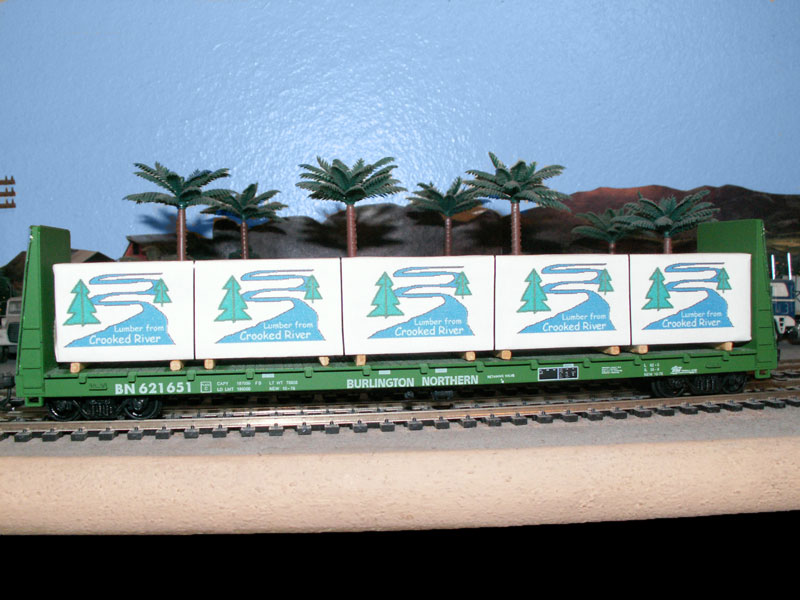Train Numbers
The lower the number the higher the priority.
| 100+ |
Yard Traffic |
Yard switchers which must sometimes go onto the yard lead |
| 51+ |
Extras |
Freight or passenger trains not on the schedule. |
| 41+ |
Local Freight |
Stop frequently to spot and pick up cars |
| 31+ |
Through Freight |
Non stop between main yards in different cities |
| 21+ |
Hot Shot |
Trailers on flat cars. |
| 11+ |
Express Freight |
Produce and other perishables. |
| 01+ |
Passenger |
Highest priority are long distance passenger trains |
East Bound has the priority because it has the steepest
grade.
East bound are odd. West bound are even.
It is important to know that trains are ran because
there is a need. Therefore many trains are related to other trains
and one cannot begin it's journey until it receives the freight from the
other train.
There are five trains which are the root of all others. Two
are passenger trains and three are freight. When they reach their destination
they either "turn" and return from where they came from, or they spawn new
trains, or they morph into a new train number and continue around the layout
for a couple of laps.
With this plan the locals always make daily pick
ups. When they return the cars are put into trains and sent off the
layout. This happens daily no matter the incoming traffic.
When traffic does come in, it is sorted in the yard and set out on the
next daily local.
The day starts off with Amtrak's Southwest Chief (01)
coming from the east, with stops in Barstow, Berdoo, and finally west. Later
in the evening it turns to become 02 heading to the east stopping again in
Berdoo and Barstow.
The Metrolink starts off it's day with 03 The Early Bird
Commute from Berdoo to Redlands. It turns to become 04 Morning Rush,
which runs from Redlands, to the west. This later turns to become 05 Lunch
Break, which runs from the west to Redlands. It again turns to become
06 Swing Shift, 07 Traffic Jammer, and 08 Grave Digger as it shuttles back
and forth between Redlands and the west. Finally Grave Digger turns
in the west, to become 09 Zombie which ends it's run in Berdoo where it is
serviced for tomorrow's work day.
The High Desert Red Eye (41) brings the daily freight,
which is to be set out in the High Desert area, up the pass. Depending
on demand, 41 could actually be two separate trains. When it reaches
Barstow it splits apart and becomes two trains if it wasn't split before.
The High Desert Local (42) and the Mine Train (48) set out the cars and pick
up yesterdays cars. When they return to Berdoo, their cars are put into
trains leaving the layout either to the east of west (31 and 32, which morph
into 33 and 34, which morph into 35 and 36 which which return as new incoming
freight, having their waybills turned or replaced. .
The North End Local (43) sets out and picks up cars from
Foothill and the North End. It (44) returns to Berdoo where the produce
cars are sent out as the Fruit Salad Express (11, morphs into 15, which morphs
into 17).
The West Side Local (45) servers the intermodal and automobile
unloading yards. When it returns, hot shots 21 and 22 go to the east
and west. These trains change numbers each time they make to a lap to
23 and 24. Finally they become incoming freight 25 and 26, for local
switching.
If it sounds confusing it isn't. In the pocket of the car
card for the lead locomotive of each train is the schedule which includes
the stops and the numbers of the blockes required for each run between the
stops. When a train is ready to leave the yard, the engineer tells the dispatcher
which blockes he needs. The run begins when the dispatcher gives the clearance.
The run ends when the train gets to a siding and waits for an oncoming train
to pass, arrives at the High Desert staging yard. or makes it to it's final
destination. While waiting on a siding or in the staging yard the car cards
for the train are placed in the holder for them so they stay near the train
because it might be a long time before that train gets it's turn to move again.
To help keep track of which train goes next, the schedule
is printed and stuck onto a metal door with refrigerator magnets. A special
magnet marks the progress of the schedule. On a seperate sheet of paper the
days of the week are listed. Another magnet marks the day of the week on the
railroad.




